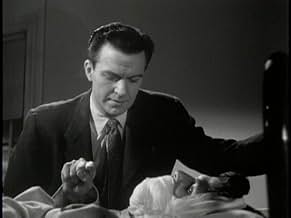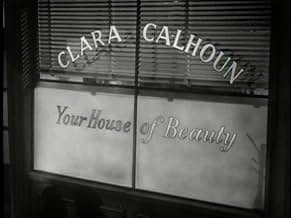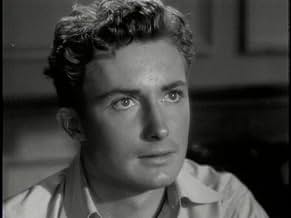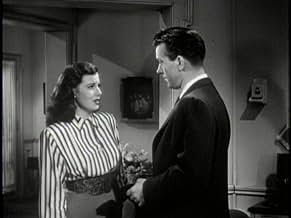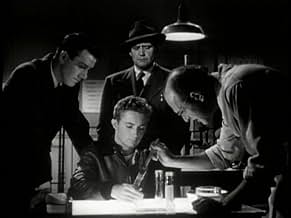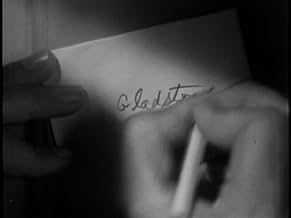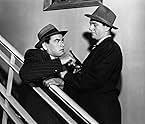IMDb RATING
6.6/10
1.9K
YOUR RATING
A beautician and her crooked boyfriend attempt to rob the bookie operation located in the back room, but when the plan goes wrong, they frame an innocent man.A beautician and her crooked boyfriend attempt to rob the bookie operation located in the back room, but when the plan goes wrong, they frame an innocent man.A beautician and her crooked boyfriend attempt to rob the bookie operation located in the back room, but when the plan goes wrong, they frame an innocent man.
Gordon B. Clarke
- Club Pianist
- (uncredited)
Ellen Corby
- Mrs. Wills
- (uncredited)
Kenneth Farrell
- Burns
- (uncredited)
Herschel Graham
- Nightclub Patron
- (uncredited)
Mira McKinney
- Beauty Salon Owner
- (uncredited)
Philip Morris
- Guard
- (uncredited)
Paul Power
- Nightclub Patron
- (uncredited)
- Director
- Writers
- All cast & crew
- Production, box office & more at IMDbPro
Featured reviews
John Ireland is a cold blooded and vile villain and Hugh Beaumont is an honest detective who's not so sure that he and his fellow overzealous cops have the right suspect (Ed Kelly) in the murder of a police officer in a gangland robbery. Toss in an evil cat fight between Sheila Ryan and Jane Randolph and "Railroaded!" becomes a prime example of Anthony Mann' superior post-war Film Noir direction. Using low lights and a suggestive script despite a low budget and grade "B" actors, Mann jumps right into the action from the start with a botched robbery that leads to not just the death of a cop, but the railroading of an innocent man. Mann builds the story up with tension and skill until the taught finale filled with gun shots, breaking glass, and confusing camera angles. It may be a "B" movie, but Mann deserves a "A" for his effort.
John Ireland's portrayal of a cold obsessed killer is the best thing in this movie. His performance is edgy, sexy and menacing. A brutal thug who loves his gun. Unfortunately he is hampered by a weak script, where his actions often make little sense. (For instance, why would he contact the sister of the suspect he framed?). Jane Randolph is also strong as the moll, although her character seems to change midway through the movie.
One of the first noir films directed by Anthony Mann, the movie is well shot, fast paced, tightly edited and tough. One wishes the focus could have stayed on Ireland, or, alternatively, the strong scenes of Ed Kelly being framed and pushed around by the cops. Mann will better develop these themes in his later films (noirs and westerns). Still a pretty enjoyable movie and a must for film noir fans.
One of the first noir films directed by Anthony Mann, the movie is well shot, fast paced, tightly edited and tough. One wishes the focus could have stayed on Ireland, or, alternatively, the strong scenes of Ed Kelly being framed and pushed around by the cops. Mann will better develop these themes in his later films (noirs and westerns). Still a pretty enjoyable movie and a must for film noir fans.
Anthony Mann directed some of the very best noirs of the 1940s and early 1950s.
This one is brutal, hard-hitting, and unrelenting till its Hollywood ended. (The ending may have been tacked on. I don't know. But it works organically with the whole, unlike many others.)
The problem for me with some of his movies, this one included, is that they are so dark they're almost impossible to see at times. Yes, it's atmospheric. But it's also frustrating.
The literal noir in some -- not all -- of his movies reminds me of the staging of Wagner at the Metropolitan Opera. Yes, it's brooding and intense. But it's also really hard to see.
This one is brutal, hard-hitting, and unrelenting till its Hollywood ended. (The ending may have been tacked on. I don't know. But it works organically with the whole, unlike many others.)
The problem for me with some of his movies, this one included, is that they are so dark they're almost impossible to see at times. Yes, it's atmospheric. But it's also frustrating.
The literal noir in some -- not all -- of his movies reminds me of the staging of Wagner at the Metropolitan Opera. Yes, it's brooding and intense. But it's also really hard to see.
A faked robbery goes awry and a cop is killed, causing the perpetrators to frame an innocent kid to take the rap. What they don't foresee is the kid's stubborn sister.
John Ireland makes one nasty bad guy, and when he lovingly polishes that gunbarrel with perfumed bullets, we get the idea. Yes indeed, he's more than just a bad guy. The movie's a crime drama done in noirish style by the expert Anthony Mann. There's little of the hallmark ambiguity of classic noir in the characters. Nonetheless, there's the innocent kid Steve (Kelly) who looks to be the victim of a malevolent noirish fate. Of course, there has to be a cheap dame in the crime mix, and Jane Randolph flops around effectively as Duke's (Ireland) brassy blonde punching bag.
Note how the movie starts out in slam-bang fashion, and how effectively Mann uses close- ups, especially of the suddenly terrified Marie (Converse), to turn screen violence into a sense of real violence. This, I think, was a Mann specialty and one reason he's treasured by fans of noir. Then too, that shootout in the shadowy nightclub amounts to a clever touch of visual imagination. No, the story itself is not exactly novel, while Beaumont makes the kind of cop you'd expect from Beaver Cleaver's dad. Still, the movie's done with style and conviction, with an outstanding turn from Ireland, and rightfully belongs in the canon of 40's noir.
John Ireland makes one nasty bad guy, and when he lovingly polishes that gunbarrel with perfumed bullets, we get the idea. Yes indeed, he's more than just a bad guy. The movie's a crime drama done in noirish style by the expert Anthony Mann. There's little of the hallmark ambiguity of classic noir in the characters. Nonetheless, there's the innocent kid Steve (Kelly) who looks to be the victim of a malevolent noirish fate. Of course, there has to be a cheap dame in the crime mix, and Jane Randolph flops around effectively as Duke's (Ireland) brassy blonde punching bag.
Note how the movie starts out in slam-bang fashion, and how effectively Mann uses close- ups, especially of the suddenly terrified Marie (Converse), to turn screen violence into a sense of real violence. This, I think, was a Mann specialty and one reason he's treasured by fans of noir. Then too, that shootout in the shadowy nightclub amounts to a clever touch of visual imagination. No, the story itself is not exactly novel, while Beaumont makes the kind of cop you'd expect from Beaver Cleaver's dad. Still, the movie's done with style and conviction, with an outstanding turn from Ireland, and rightfully belongs in the canon of 40's noir.
Railroaded (1947)
An almost amazing movie, well made, beautifully photographed, held back by a stiff script but still it manages. And it has a dark current that makes it both creepy and contemporary. Director Anthony Mann seems to have made a dozen great films that are just under the radar, noirs and westerns that have some edge to them to keep them from falling into the abyss of their genres.
This is Mann at his mature earliest. He had made a few films in the earlier 40s, but this, along with "Desperate," marks his coming into his own. Yes, you might find too much of a formula at work here, but it's not derivative, just a little stilted in the dialog. And yes, you might ask, near the beginning, why the cops couldn't see how easy the frame up would be (anyone could have stolen the truck and committed the crime), but remember, this one fact was supported by several others, including an eyewitness confirmation. So, once over these humps, you are for a good ride.
Who to watch for amongst these relative unknowns? John Ireland, most of all, for his bad guy personification, all charm and heartlessness, simultaneously. His girlfriend, played by Sheila Ryan, is his match, in a sharp performance also dripping with selfish cruelty, but tempered, critically, by doubt and remorse.
The third star is the little known cinematographer Guy Roe, who must have been inspired by the young, rising director. The filming right from the opening, subtle crane shot of the beauty parlor facade is artfully gorgeous without becoming baroque the way Orson Welles had become (beautifully) by 1947 with "The Lady from Shanghai." Both are great examples of where the movies were just after the war, both with a dark, brooding, searching uncertainty. And both showing off the amazing movie-making machinery of post-War Hollywood. I say this because both films were smaller budget affairs, and yet they have uncompromised production.
Give this a serious look. It's imperfect, for sure, but it has such high points, including some dark dark filming that is so kinetic and scary it surprised even an old film noir fan like me, you'll be glad.
An almost amazing movie, well made, beautifully photographed, held back by a stiff script but still it manages. And it has a dark current that makes it both creepy and contemporary. Director Anthony Mann seems to have made a dozen great films that are just under the radar, noirs and westerns that have some edge to them to keep them from falling into the abyss of their genres.
This is Mann at his mature earliest. He had made a few films in the earlier 40s, but this, along with "Desperate," marks his coming into his own. Yes, you might find too much of a formula at work here, but it's not derivative, just a little stilted in the dialog. And yes, you might ask, near the beginning, why the cops couldn't see how easy the frame up would be (anyone could have stolen the truck and committed the crime), but remember, this one fact was supported by several others, including an eyewitness confirmation. So, once over these humps, you are for a good ride.
Who to watch for amongst these relative unknowns? John Ireland, most of all, for his bad guy personification, all charm and heartlessness, simultaneously. His girlfriend, played by Sheila Ryan, is his match, in a sharp performance also dripping with selfish cruelty, but tempered, critically, by doubt and remorse.
The third star is the little known cinematographer Guy Roe, who must have been inspired by the young, rising director. The filming right from the opening, subtle crane shot of the beauty parlor facade is artfully gorgeous without becoming baroque the way Orson Welles had become (beautifully) by 1947 with "The Lady from Shanghai." Both are great examples of where the movies were just after the war, both with a dark, brooding, searching uncertainty. And both showing off the amazing movie-making machinery of post-War Hollywood. I say this because both films were smaller budget affairs, and yet they have uncompromised production.
Give this a serious look. It's imperfect, for sure, but it has such high points, including some dark dark filming that is so kinetic and scary it surprised even an old film noir fan like me, you'll be glad.
Did you know
- TriviaA policeman says, "The more I see of them [criminals], the more I love my dog." This was originally said by the French author Mme. de Sevigne, but she meant "them" to refer to all men.
- GoofsReading from a book, Jackland Ainsworth quotes, "Some women should be struck regularly - like gongs", adding, "That's from Oscar Wilde, you know." In fact, it's a quotation from Noel Coward's play, "Private Lives".
- ConnectionsReferences Fortunes rapides (1931)
- How long is Railroaded!?Powered by Alexa
Details
- Release date
- Country of origin
- Official sites
- Language
- Also known as
- Railroaded!
- Filming locations
- Production company
- See more company credits at IMDbPro
Box office
- Budget
- $500,000 (estimated)
- Runtime1 hour 12 minutes
- Color
- Aspect ratio
- 1.37 : 1
Contribute to this page
Suggest an edit or add missing content



